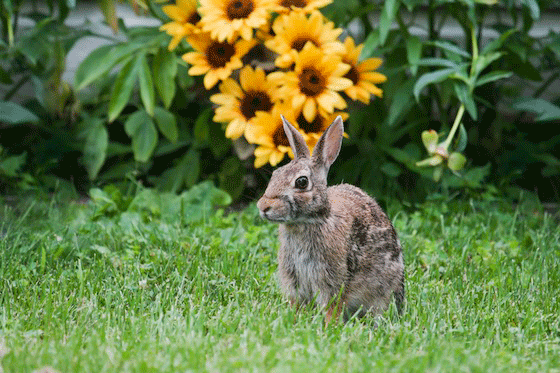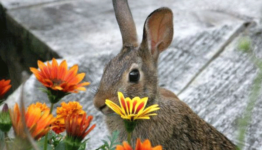In this article we will discuss rabbit repellent methods. North America has seen a dramatic increase in rabbit population in recent years. According to wildlife population experts, rabbit’s number in the millions inhabiting every state in the union resulting in crop and landscape damage estimated to be in the millions annually. Wild rabbits have an amazing ability to reproduce and to repopulate areas. A single female rabbit can have 1-14 babies per litter; the average litter size is about 6. Rabbit gestation lasts 28-31 days. This means that a mother could potentially have one litter per month.
Using an integrated approach for repelling rabbits and restricting rabbit populations and movement is the most effective way to reduce damage. The greatest amount of protection comes from using a variety of rabbit repellent products and or methods. The key to preventing rabbit damage is to stop it before it occurs.
Selecting rabbit proof plants that are less likely to be eaten is a common strategy used in protecting gardens, ornamentals and landscaping. Websites, magazines and catalogs often advertise “rabbit proof” plants but the reality is that no plant is truly rabbit proof. Some plants are indeed less likely to be eaten than others because of their taste, texture, or odor but hungry rabbits will consume almost any plant to survive.
Rabbits are extremely aggressive and will consume just about any green vegetation in the spring and summer, especially as the new growth emerges. When selecting rabbit-resistant plants, you may want to consider the fact that rabbits typically dislike plants with sticky/hairy leaves and stems; plants with thorny/prickly leaves and stems (roses being an exception); plants that are poisonous or that secrete a thick sap and also those with strong unpleasant smells, pungent tastes and strong odors. Please take into consideration the fact that this does not mean homeowners are limited to only planting rabbit resistant plants. One of the many rabbit safe strategies is to stager plant by planting at least two rabbit resistant plants for each susceptible plant. Consider using rabbit resistant plants as a boarder around irresistible gardens and flowerbeds, helping to deter rabbits and other animals.
Choosing rabbit resistant plants can be a challenging task and may be too much for the average grower to incorporate. Another option is to install a physical barrier such as fencing or netting. To protect gardens and landscaping from foraging rabbits, some growers will install plastic or woven wire fence as a rabbit deterrent. For shrubs, netting is sometimes spread over plants. This will also protect against other browsing animals such as deer and elk. However, wire fencing and expensive netting can sometimes be cost prohibited and less than appealing.
Commercial rabbit repellent products are effective when used properly. A variety of factors including weather, the availability of other food, and the rabbit’s appetite will more often play a major role in their effectiveness. Rabbit repellents often are required to be applied regularly and after significant rain fall. Some rabbit repellents claim to be











